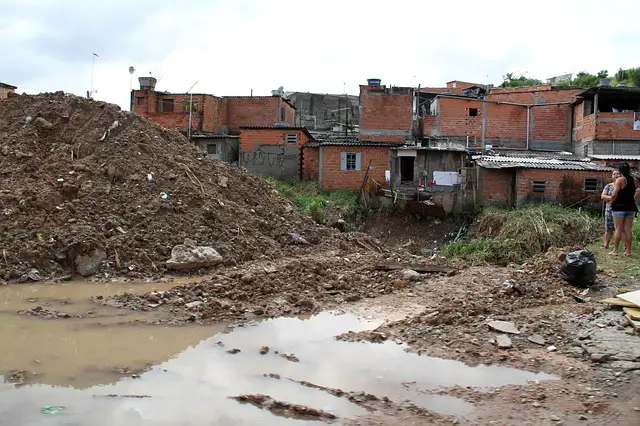The environmental quality of urban areas has a dramatic effect on the health status of all urban residents. No one can escape the effects of poor air and water quality, inadequate sanitation, a lack of proper solid waste management, and the improper storage and emission of hazardous substances. Poverty and the desire to promote economic prosperity can lead to the unsustainable exploitation of the environment where city managers and business leaders are unable or unwilling to manage the intricate links between economic growth and environmental quality. Sadly, this approach tends to fail in the long-run as the productivity of the local labor pool is degraded and environmental resource stocks are drawn down at an unsustainable rate.

While the entire urban population suffers from poor environmental quality, the poor tend to be the most vulnerable as they are often living in marginalized parts of the city, contiguous with waste sites and well beyond the reach of water, sanitation and other environmental services. High population densities, toxic effluents in the soil and water, air pollution, smoke from cooking fires and lack of adequate water, sanitation and solid waste services contribute to the poor environmental quality of informal urban settlements and the high morbidity and mortality rates of their residents. Impoverished populations are also more vulnerable to accidents, criminal behaviors and disaster (floods, earthquakes and landslides). The quality of local infrastructure – such as unsafe electrical wiring and streets that are so narrow that emergency vehicles cannot get through – not only increases the likelihood of accidents such as fires, but generates more catastrophic results when accidents occur. Public safety officers may view informal settlements as dangerous or hopeless, and thus ignore crimes that happen within their borders. The poverty of residents in informal settlements also means that they are likely to be located on plots of land that are precariously perched on the side of hills and mountains or in flood plains where at best, a good rain will leave pools of water feeding numerous disease vectors and at worst, might wash them away.
The urban poor bear the health consequences of poor environmental quality more dramatically than other urban residents because they do not have sufficient resources to invest in infrastructure improvements. The negative consequences of poor environmental quality impact every aspect of their lives. Poor environmental quality reduces the ability of children to learn, leading to a decreased earning capacity as adults. It also leads to the loss of valuable workdays and increases the need for individual and public health care expenditures, decreasing the net income with which families can buy food and other necessities. A consequent decrease in the nutritional status of families begins a vicious cycle that must be broken if the urban poor are to find a more prosperous future.
While the current situation is severe, there is considerable evidence that low-cost environmental improvements and expanded education can dramatically improve the health and well-being of poor urban residents. This brief will outline the issues and direct the reader to resources that can assist in the implementation of effective environmental health interventions in cities.
Pro-Poor environmental health Programming Considerations
When approaching the environmental health interventions, it is useful to think in terms of at least three possible actions :
- The reduction or removal of environmental hazards
- Reduction of the impacts of the illness or injury when it occurs
- Treatment and management of illness and/or disability arising from a hazard
The first course of action is, of course, the preferred option both because it reduces the level of human suffering and because it is likely to be more cost-effective (in terms of productivity and health care costs) in the long-run. All three options have their place, however, depending on the given context and/or resources involved.
Infrastructure, Services and Behavior Change
In most cases, the most cost-effective approach to disease prevention is the combination of improved delivery of environmental infrastructure with the education of population that use these services. Despite compelling evidences supporting this position, efforts to implement environmental improvements along side health interventions rarely occur.
Environmental health priorities are often ignored because their causes are related to a wide spectrum of development issues and thus involve a diverse group stakeholders who are not trained to manage the health impacts of their activities. In the urban context, government stakeholders often work in separate ministries or district offices and often do not consult each other in the planning process. Donors tend to work along sectoral lines as well and are rarely able or willing to bridge the divide between environment infrastructure, services and health. Interventions are further challenged by the complexity of the relationship between the environment and health. Where governments and donors are paying attention to environmental health concerns it tends to be with a focus on immediate rather than long-term impacts (e.g. occupational exposure to and the immediate use of chemicals rather than their accumulation in the watershed). Policy solutions are designed accordingly and thus may not properly catch or address many important areas for concern. Effective environmental health interventions must involve a wide coalition of stakeholders, proper analysis of short and long-term environmental use impacts and the development and implementation of effective policies that respond accordingly.
Water & Sanitation Infrastructure
Diarrheal diseases kill 1.5 million children a year. An untold number – estimated to be in the millions – are mentally and physically debilitated from repeated attacks of this water and food-borne disease. Diarrhea competes only with Acute Respiratory disease as the number on killer of children. Urban environmental health levels are strongly related to the availability of clean, affordable and plentiful water, as well as services to collect, dispose of and process human excreta, wastewater and solid waste.
Hygiene education programming is also a critical component. Investments aimed at increasing awareness and changing of hygiene behaviors, such as regular hand washing or the regular emptying and maintenance of public latrines, greatly reduce urban morbidity and mortality rates from water and hygiene-related diseases. In informal settlements, these types of investments can achieve environmental health impacts that are more immediate, cost-effective, and equitably distributed than the adoption of water or sanitation infrastructure investments alone. Without the necessary water and sanitation infrastructure and hygiene education, the urban poor face high morbidity rates that will undermine their productivity and profoundly effect their ability to pull themselves out of poverty.

Solid Waste Management
Nearly half of the waste generated by urban residents in developing countries lays unsegregated, in open dump sites and on city streets. Waste piles become feeding grounds for disease vectors, clog drains generating floods and contaminate aquifers vital to the survival of urban populations. Scavengers, who often rely on waste for income, sacrifice their health by sorting through unsegregated waste for goods they can use or sell. Management of toxic waste from hospitals, factories, and power plants is serious concern for all city residents but disproportionately effects the poor as heavily polluted areas are more likely to be vacant and thus available for low cost settlement. Developing cities must find ways to ensure collection and safe storage of waste without jeopardizing the livelihoods of scavengers who depend on the waste for survival.
Air Quality
Indoor air quality in informal urban settlements is typically very poor as a result of inadequate ventilation, inefficient and smoky cooking fuels and lack of understanding of their health impacts. Poor indoor air quality contributes to respiratory and vision problems and general ill health. Interventions should be based on improving ventilation and access to health awareness programming. Outdoor air quality and combating pollution, on the other hand, impact rich and poor alike and thus call for policy interventions of a larger scale, capable of developing market-based incentives to encourage the adoption of clean-technologies.

Accidents
Crowded, densely populated slums, the lack of services and poorly maintained infrastructure lead to an increase in the number of accidents that will occur and the likelihood that their impact will be deadly. Dense populations and traffic contribute to frequent motor vehicle and transportation accidents. Overcrowded and unsafe slum housing inevitably leads to accidents, including fires. This is particularly true where the household serve as a production site during the day. Outside of the home, lack of enforceable safety regulations and poorly maintained public works and infrastructure projects can also lead to accidents. Finally, in informal settlements, distances from health care facilities and/or inability to pay, can prevent effective care resulting in grave impacts from seemingly harmless accidents.
Improved urban environmental management and land use planning can help urban policy members control the growth and direction of informal settlements and their respective levels of environmental quality, as well as lessen the impact of accidents and disasters when they inevitably happen. Outreach programs that bring health services and education to slum populations are also necessary if we are to mitigate the effect of environmentally caused accidents.
Expanded Reach of Health Services
Where we are unable to eliminate environmental hazards, it is imperative that we are able to reach the poor with health services and education that will mitigate their impact. Proper coverage with the full round of immunizations, low cost water purification and sanitation technologies, education about correct hygiene behaviors and ready availability and access to emergency services are vital if we are to improve the health status of the urban poor.
Tenure Security
Without the security that legal recognition provides, the poor are unwilling to make permanent investments in water, sanitation, and housing. Lack of tenure security makes most proper housing unaffordable or inaccessible (there is no incentive to re-invest in or improve access to housing condition and environmental health services). These vulnerabilities contribute to the growth of informal settlements and slums, resulting in the permanent or semi-permanent populations living in disaster-prone and polluted areas, adding to future environmental health costs.
Participation & Community Planning
Stakeholder coordination and participation in the process of developing and implementing environmental health programming for the poor is a vital part of success in the long-run. Policy-makers need to solicit active representation from the urban poor communities who will become the end-users or projects will likely fail. The urban poor residents are best placed to be able to assess and prioritize their environmental health interests and needs. In addition, they bring with them social networks that can help streamline the implementation of environmental health needs assessments and programming, such as community-based micro health insurance, resulting in interventions that are more cost effective and whose benefits are more equitably distributed.
Related Articles:
- Community Participation | Types, Process & Facilitation
- Sherry R Arnstein’s Ladder of Citizen Participation
- Examples of Public Private Partnership (PPP) Projects
Finance and Cost-Recovery
The development of adequate finance and cost recovery mechanisms are two major challenges to be faced in expanding the reach of environmental services. In an era of decreasing aid and shrinking central government budgets, cities must find new and innovative ways to draw upon their own capital markets for financing. Where cities are able to garner the trust of investors through transparent and rational fiscal policy and practices, this becomes a very real option. The private sector can also be engaged as a valuable partner. However, services and infrastructure can only be delivered successfully over the long-run if tariff structures are designed to achieve full cost recovery. There are many ways to achieve full cost recovery and still protect the access of impoverished populations. First, policy-makers must realize that, absent formal services, the poor pay several times the going rate to obtain vital services (such as water) from private vendors. Second, it is possible to draw from a variety of toolkits to ensure that the poor are able to obtain affordable access. Low-cost, appropriate technologies can be provided in place of more expensive systems. Progressive rate structures can also be implemented. Community health micro-insurance schemes may be effective interventions to help ensure that the poor are not further devastated by illness.
Good Governance
Good governance is required to build successful environmental health policy frameworks capable merging the differing health priorities of the urban poor with the capacity and resources of those expected to provide services. This requires multi-sectoral participation and stakeholder consultations in order to both fully understand the range of environmental health priorities as well as the potential solutions coming from NGOs, PVO, community-based enterprises and the private sector.
Note: The article above is not written by Planning Tank/ Its members or contributors. It is a part of number of valuable information which is now lost because the original source of this content has been deleted/ moved/ inaccessible/ archived. We are making an attempt to bring valuable content from over the internet and other sources which we believe will be helpful for people. We do not own any rights to this content. For any queries/ complaints/ feedback/ removal requests kindly contact us through email.